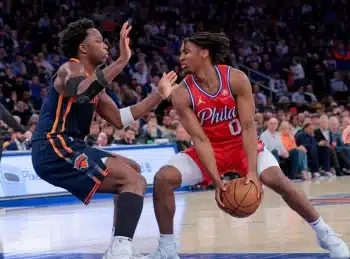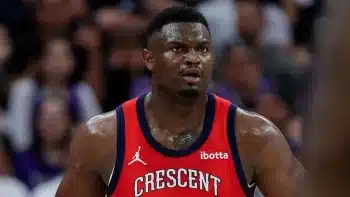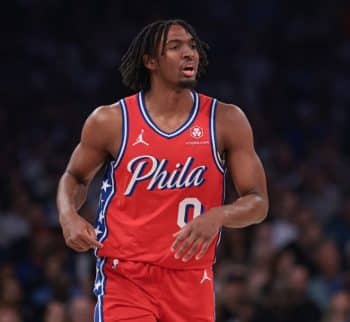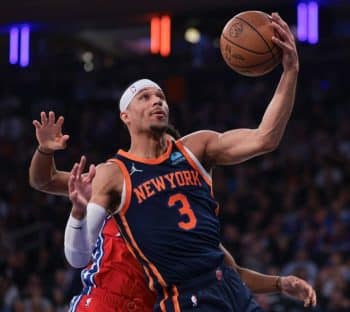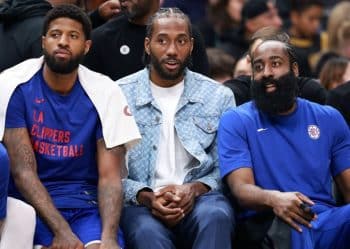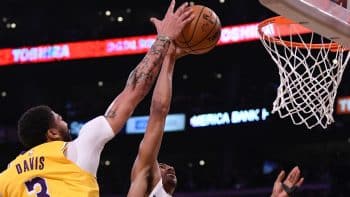NBA
NBA AM: The History of Trading #1 Picks

While Father’s Day Weekend was absolutely loaded with insane NBA hullaballoo regarding potential Paul George trades and slightly less prominent Jimmy Butler trades, one draft trade actually happened, the first swap between teams since February 23, and it was a doozy.
The Boston Celtics agreed to trade the number one overall selection in Thursday’s NBA Draft to the Philadelphia 76ers for the third selection this year and another first round pick to be redeemed in the next year or two. Philadelphia will take Markelle Fultz with the pick, and nobody has any solid idea what Boston will do with the third pick, or even if they’ll still have that pick by Thursday.
What is interesting is that this is only one of a handful of times in league history that a team has traded the first overall selection between the time that the draft order was announced and the actual start of the NBA season. “The Markelle Fultz Trade,” as this probably will be called in perpetuity, is one of only seven instances that a team has traded either the top pick or the player selected with the first overall pick before he ever was able to play a single game for his own new team.
Per USA Today’s Adi Joseph:
Historical perspective on the No. 1 pick being in trades: The team making the trade only regretted it once, in 1986. (CORRECTED CHART.) pic.twitter.com/HSBgKGvEig
— Adi Joseph (@AdiJoseph) June 16, 2017
That’s a list with some huge names on it, which isn’t surprising considering the first overall pick typically involves a transcendent, possibly generational player. Considering the dejection of Boston Celtics fans immediately following the Markelle Fultz trade on Saturday, this feels like a perfectly appropriate time to explore whether or not the teams trading away the top pick ended up with seller’s remorse at any point down the road.
2014: Cleveland Cavaliers’ first overall pick Andrew Wiggins is traded as part of a package to the Minnesota Timberwolves in exchange for Kevin Love. Only three years later, we’re talking about Cleveland dangling Love again to possibly rein in Paul George on a one-year rental in hopes of having a better chance at winning another title with LeBron James. Still, there’s no question this deal worked out pretty well for the Cavaliers. With Love in tow, the Cavs have made three straight NBA Finals and have a Larry O’Brien trophy to show for it. Wiggins has been really good, but he wouldn’t have given the Cavs a better shot at winning a ring—not this soon, anyway.
1993: Orlando Magic’s first overall pick Chris Webber is traded to the Golden State Warriors for Penny Hardaway and three future first-round picks. In a lot of ways, this trade looks a lot like the one that Boston and Philadelphia just executed. Golden State, who had the third pick that year, really wanted consensus Chris Webber and made a massive gamble in offering the third pick and three future first rounders to get him.
Hardaway really impressed the Orlando front office, going so far as to call those execs multiple times ahead of the draft to beg for the opportunity to play for them. He knew they were leaning toward drafting Webber, but Hardaway flat-out told them that was a mistake. He did a full-court scrimmage with other college players the week before the draft and convinced Orlando to make the deal to pair Penny with Shaquille O’Neal. The later first-round picks did okay, too. In 2001, for example, one of those picks became Rookie of the Year Mike Miller.
But Hardaway obviously didn’t make it long in the league before experiencing a series of devastating injuries. There were four great seasons with Penny and Shaq, but after that, it was pretty clear that Webber was the better long-term pro, even if that didn’t wind up being with Golden State. Frankly, this trade probably worked out better for Orlando long-term, even if Webber ended up being the better player. It’s hard to say that, equipped with the information they had at the time, they made a mistake. They really didn’t. Three extra first-rounders is a ton of value to drop two spots to take the player you liked better anyway.
1986: Philadelphia 76ers first overall pick Brad Daugherty is traded to the Cleveland Cavaliers for forward Roy Hinson. Coming off a 54-win season, the Sixers looked primed to get even better by adding the top overall selection in that year’s draft. Charles Barkley was the team’s cornerstone at the time, and with Julius Erving and Moses Malone not getting any younger, the idea of adding the top overall pick would have helped solidify the team’s future considerably. Instead, Philadelphia shipped off Malone and that top pick in the same day, with the draft selection getting swapped for Hinson and $800,000 cash—a ton of money for the NBA in 1986.
To be fair, Philly GM Pat Williams (who coincidentally ended up in Orlando and also would ship off the top overall pick in the Penny Hardaway trade seven years later) admitted it was hard to get a grasp on that infamous draft class, which featured several players who struggled with drugs. Daugherty wasn’t one of those guys, however, and he’d go on to make five All-Star teams in his eight-year career with the Cavaliers. Hinson played only a single season for the Sixers.
1980: Boston Celtics top overall pick Joe Barry Carroll is traded along with Rickey Brown, the 13th pick, to the Golden State Warriors in exchange for third overall pick Kevin McHale and Warriors center Robert Parrish. Let this serve as evidence that maybe Boston knows what it’s doing in trading down. Danny Ainge obviously isn’t Red Auerbach, but this is a trade where the team acquiring the top overall pick is the one struggling with the decision rather than the team sending it away. Not only did the Celtics win the NBA title that very season (they won only 29 games the year prior in Larry Bird’s rookie season), but they also put together a Hall of Fame frontcourt for the next decade.
***
The other two instances of teams trading away the top overall pick were both in the 1950s, long before anything we’d consider the “Modern NBA,” so they don’t really have much impact in terms of historical analysis as to whether or not moving that pick tends to be regretful.
Based on the rest of the sample size, though, we have an instance in which trading the top pick was a huge mistake, one where it proved a masterstroke of genius, and two where both teams got exactly what they wanted out of the deal with no real definitive “winner” or “loser” of the trade.
Since the last two instances of top overall picks are the ones that turned out so evenly, it’s easy to see how this deal could end up similarly, but it obviously is too easy to call it either way. Ainge either will be seen as the guy who traded away a superstar in Fultz, or he will be viewed as the guy who somehow ended up with seven first-round picks in two drafts, more than enough to use those assets to assemble an elite superteam in Boston.
It will be years before we get an answer, but the historical odds seem to suggest that, at the very least, he won’t really, really regret it.
